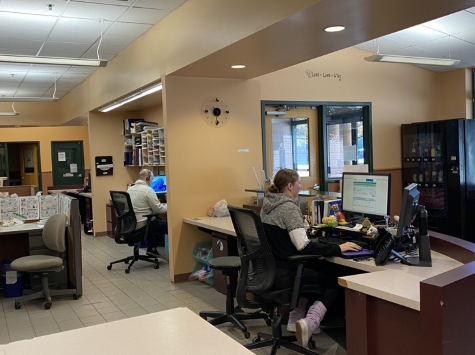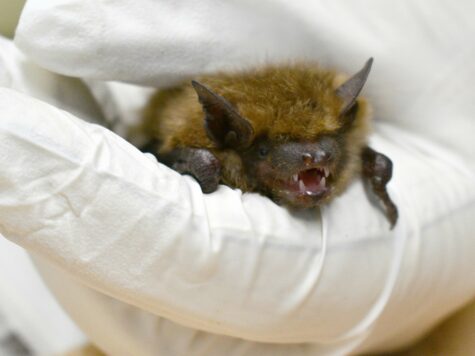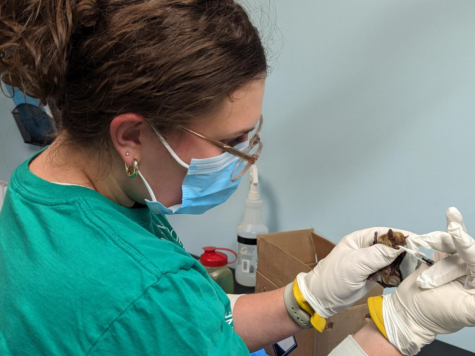They’re often called “receptionists,” but their responsibilities extend far beyond what we tend to assume receptionists do. Theirs is the first face someone sees upon entering the shelter, and they are often the first point of contact for both the public and animals alike. They schedule appointments for everything from surrendering an animal to getting a pet microchipped, they counsel pet parents on animal behavior, they help reunite lost pets with their loving families, and they facilitate surrender appointments.
They’re Dane County Humane Society (DCHS) Shelter Resource Counselors.
Want to learn what life is like for a DCHS Shelter Resource Counselor? Read on to learn about their role in the journey of our two friends, Max and Lily.
This is Max:

Max is out on a walk with his family. During their stroll, Max spots a very interesting squirrel he wants to make friends with. In his eagerness to say hello, Max takes off, and he soon finds himself alone in an unfamiliar environment. Try as he may to sniff out his home, Max quickly realizes that he is lost.
Not too long after, a good Samaritan finds Max and wants to help. His first instinct is to ask DCHS, so he pulls up giveshelter.org/found to find the phone number and check for suggestions of what else he might do. He leaves a voicemail with the front office, and while he waits for a call back, he reviews the other suggestions the website lists for helping lost pets get back home.
Unfortunately, Max has no tags on his collar, but he does have a leash, so the finder and Max start walking around the neighborhood on the off chance they find someone who recognizes Max. The finder knows DCHS can scan for a microchip, and in the meantime, he snaps a photo of Max to post on community social media sites for lost pets.
And then he gets a call back! The friendly Shelter Resource Counselor thanks him for taking such an active role in helping Max get back to his family, and gathers more information: What kind of dog is Max? What color coat does he have? Does Max look young, adult, or old? Is he neutered? Where was he found and when? Is he wearing a collar? Does he have any distinguishing features?
The finder is asked to hold while the Counselor checks this information against lost animal reports. If they find a match, then all is well! The Counselor can tell the finder that Max has a family searching for him and help coordinate a way for the family and finder to get in touch.
But what if Max’s family was so busy looking for him that they forgot to file a lost report?
In this case, the Counselor advises Max be scanned for a microchip. The finder could have this done at a vet clinic, call animal services, or bring Max to DCHS. Unable to hold onto Max long term, the finder decides to bring him to the shelter. At DCHS, Max is greeted with friendly faces and fed lots of yummy treats while a Counselor scans his entire body for a microchip. Max is so happy with all of the treats and the friendly Counselor caring for him, that he barely notices the “beep beep beep” of the scanner.
The Counselor disappears behind a computer where they enter the microchip ID number into a database and make some calls in an attempt to track down Max’s family. Meanwhile, the shelter is busy as interested parties walk through to look at and visit adoptable animals, and phones ring with inquiries about lost pets, surrender, adoption, pet care tips, other pet services, and for general information. Max hears the sound of the printer as staff and volunteers are busy readying and scanning paperwork.
The Counselor who gave him treats returns and speaks to the finder. The good news is they found a chip! Unfortunately, it was unregistered. Given this information, the finder is presented with a few options: he can file a found report and let Max stay with him or fill out a stray contract so DCHS can shelter Max while continuing the search for his family.
The finder decides Max would be safest in DCHS’s care. He fills out the paperwork, and Max is escorted into a kennel so he can be admitted. Max’s family will have four days to come forward before DCHS will evaluate him for adoption. During those four days, front office staff and volunteers will continue to run daily checks through lost reports, call his microchip implant facility (i.e. the vet clinic, other shelter, etc. that chipped Max originally) to find out whether they have additional information not on the unregistered microchip, and do all the detective work they can to find Max’s family.
Luckily, just one day after Max is brought to the shelter, his family calls DCHS to file a lost pet report. Based on the family’s description of their dog, lost location, and date he went missing, shelter staff are able to determine the report is a match to Max! The family comes in, presents ID, vet paperwork, and pays the redemption fees needed to cover the cost of Max’s stay.
Before long, Max is greeted by a staff member at his kennel. At first, he thinks he is going for another walk outside, but the closer and closer to the front of the shelter Max gets, the more and more Max begins to pick up on a familiar scent. He walks just a little bit faster, anticipating, hoping... and then that familiar smell accompanies a familiar voice, and the familiar voice turns into a familiar, happy face.
His family is here! They found him! Max runs to his family, jumping and barking with joy! It’s only been a day, but it feels like a million years. He and his family head home happy, tired, and together at last.
The Shelter Resource Counselors in the front office are glad to see them reunited, but as Max’s shelter journey comes to an end, another animal’s journey begins.
Meet Lily:

Lily is a 10-year-old cat. She’s calm, she’s friendly, and she used to be perfectly content as an only cat. And then a new human moved in. Now, her once-quiet environment is filled with the piercing sounds of a baby’s cry, and her family has to spend her time with the new human.
With so much change, Lily begins having accidents on the baby's belongings. Her family, however, isn't able to help Lily with the new baby occupying all of their time.
Eventually, Lily’s accidents prompt her family to contact DCHS about surrender. They are concerned about the baby’s health, their carpets, and, most importantly, Lily’s happiness. It’s a difficult decision to make, but one they think is best for both the family and Lily, who they believe would be happiest in a home without a baby.
DCHS follows a managed admission philosophy, so before bringing Lily in to the shelter, her parent schedules a phone consultation with a Shelter Resource Counselor. During the call, the Counselor asks questions about Lily's behavior in the home. They recommend a few things to try, such as taking Lily to the vet to rule out any medical reason for the litterbox problems and offer to send handouts about stress relief and fixing litterbox problems at home. They also recommend ways Lily’s family can rehome on their own.
Lily’s family accepts the resources and fills out a behavior profile for DCHS so staff can evaluate what needs Lily will have. In an ideal world, Lily’s family will find ways to alleviate her stress and resolve her litterbox issues. If this isn’t possible, the next best outcome is for the family to find a new home for Lily on their own via DCHS’s rehoming webpage or their own network. However, sometimes the only option a person has is surrender, and in that case, DCHS is ready and willing to help.
Lily and her parent arrive at the shelter for their appointment, and Lily is brought into a room and set on a table in her carrier. A Shelter Resource Counselor sits down with Lily’s parent to go over paperwork. They ask questions about Lily’s behavior. Lily’s parent is more emotional than she expected to be, and she tears up a bit during the conversation. It’s difficult to surrender a pet, even if you know it’s the best move for your pet and family at that point in time. The Counselor reassures Lily’s parent that they and DCHS understand and are not judging her for her decision. They ask these questions because it’s important to gather an accurate picture of behavior in the home so Lily can be properly assessed by DCHS staff and placed in a home where she will be happy.
The pet parent and Counselor fill out the personality profiles together and go over the surrender contract. By the end of the appointment, both pet parent and Counselor are teary-eyed. It’s a bittersweet moment, but the former pet parent leaves feeling reassured that Lily will be provided for at DCHS until staff can find her a new home.
Lily trades the carrier for a kennel. Over the next couple of days, staff evaluate her behaviorally and medically. She’s made available for adoption, and the profiles the Counselor helped her former parent fill out are used as a vital instrument in finding her a new family.
A few weeks later, she’s no longer at the shelter. She misses her old home, but this new one is nice. She has a warm lap to cuddle on and big windows to watch wildlife through. There’s no crying baby, and Lily finds lots of sunspots to nap in. She uses the litterbox again. She’s happy.
DCHS staff save Lily’s adoption success story as a reminder that the work we do makes a difference. A moment of enjoying that warm, fuzzy feeling, and with a smile, our Shelter Resource Counselors move onto the next case.
Can you see yourself helping pets and families in our community with their questions, concerns, and challenges? Find our current job openings (including for Shelter Resource Counselors!) here.
*NOTE: Due to staffing shortages, we may not be able to answer your call. Please leave a detailed voicemail and make sure to include your contact information. You and the animal you are calling about are important to us, and you WILL receive a response; however, non-emergency phone calls and emails may take up to 48 hours. In the meantime, our website has helpful information, and in some cases forms you can fill out and submit online. Helpful topics you can find on our website include surrendering a pet, rehoming a pet, what to do if you lost a pet, what to do if you found a companion animal, microchipping pets, dog training classes, pet care and behavior tips for a variety of companion animals, how you can help animals in need (donate, volunteer, host a fundraiser, etc.), and more!
Sarah Hudson is a Senior Shelter Resource Counselor at DCHS






